Yi-Zhe Song
Amadeus: Autoregressive Model with Bidirectional Attribute Modelling for Symbolic Music
Aug 28, 2025Abstract:Existing state-of-the-art symbolic music generation models predominantly adopt autoregressive or hierarchical autoregressive architectures, modelling symbolic music as a sequence of attribute tokens with unidirectional temporal dependencies, under the assumption of a fixed, strict dependency structure among these attributes. However, we observe that using different attributes as the initial token in these models leads to comparable performance. This suggests that the attributes of a musical note are, in essence, a concurrent and unordered set, rather than a temporally dependent sequence. Based on this insight, we introduce Amadeus, a novel symbolic music generation framework. Amadeus adopts a two-level architecture: an autoregressive model for note sequences and a bidirectional discrete diffusion model for attributes. To enhance performance, we propose Music Latent Space Discriminability Enhancement Strategy(MLSDES), incorporating contrastive learning constraints that amplify discriminability of intermediate music representations. The Conditional Information Enhancement Module (CIEM) simultaneously strengthens note latent vector representation via attention mechanisms, enabling more precise note decoding. We conduct extensive experiments on unconditional and text-conditioned generation tasks. Amadeus significantly outperforms SOTA models across multiple metrics while achieving at least 4$\times$ speed-up. Furthermore, we demonstrate training-free, fine-grained note attribute control feasibility using our model. To explore the upper performance bound of the Amadeus architecture, we compile the largest open-source symbolic music dataset to date, AMD (Amadeus MIDI Dataset), supporting both pre-training and fine-tuning.
SketchAnimator: Animate Sketch via Motion Customization of Text-to-Video Diffusion Models
Aug 10, 2025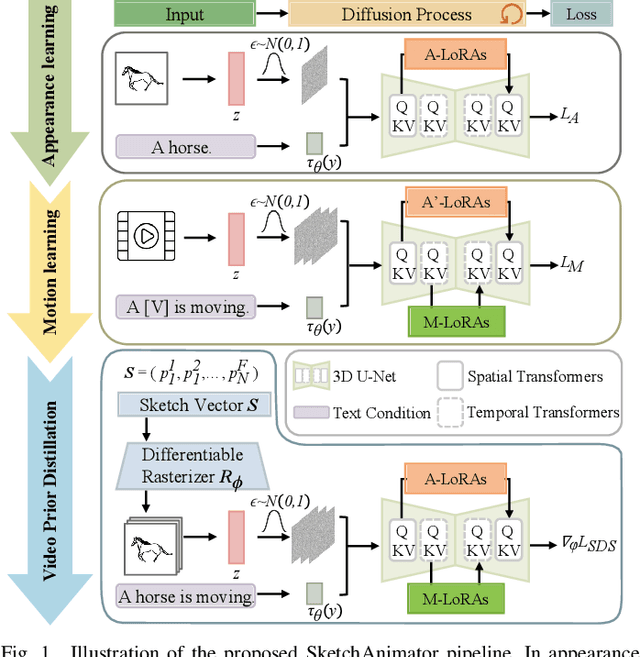
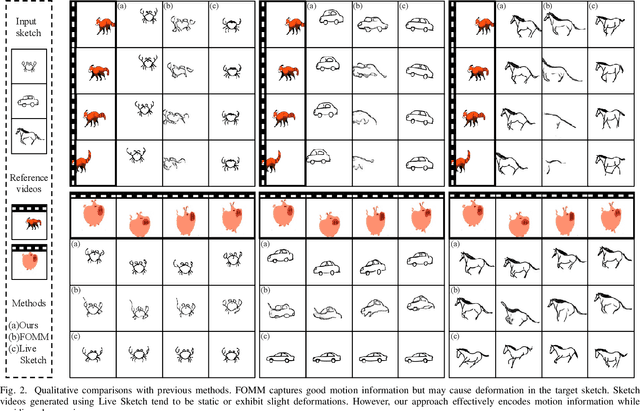
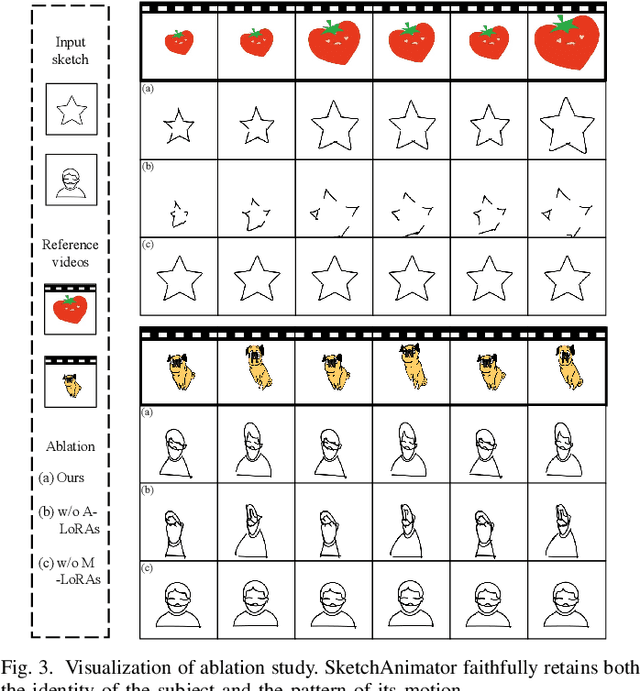
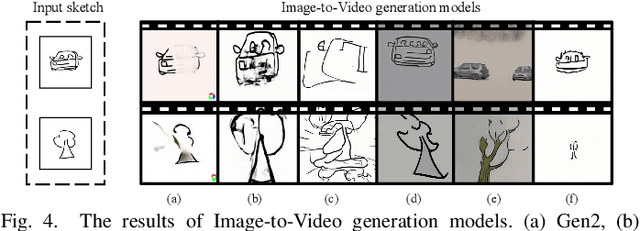
Abstract:Sketching is a uniquely human tool for expressing ideas and creativity. The animation of sketches infuses life into these static drawings, opening a new dimension for designers. Animating sketches is a time-consuming process that demands professional skills and extensive experience, often proving daunting for amateurs. In this paper, we propose a novel sketch animation model SketchAnimator, which enables adding creative motion to a given sketch, like "a jumping car''. Namely, given an input sketch and a reference video, we divide the sketch animation into three stages: Appearance Learning, Motion Learning and Video Prior Distillation. In stages 1 and 2, we utilize LoRA to integrate sketch appearance information and motion dynamics from the reference video into the pre-trained T2V model. In the third stage, we utilize Score Distillation Sampling (SDS) to update the parameters of the Bezier curves in each sketch frame according to the acquired motion information. Consequently, our model produces a sketch video that not only retains the original appearance of the sketch but also mirrors the dynamic movements of the reference video. We compare our method with alternative approaches and demonstrate that it generates the desired sketch video under the challenge of one-shot motion customization.
Annotation-Free Human Sketch Quality Assessment
Jul 28, 2025Abstract:As lovely as bunnies are, your sketched version would probably not do them justice (Fig.~\ref{fig:intro}). This paper recognises this very problem and studies sketch quality assessment for the first time -- letting you find these badly drawn ones. Our key discovery lies in exploiting the magnitude ($L_2$ norm) of a sketch feature as a quantitative quality metric. We propose Geometry-Aware Classification Layer (GACL), a generic method that makes feature-magnitude-as-quality-metric possible and importantly does it without the need for specific quality annotations from humans. GACL sees feature magnitude and recognisability learning as a dual task, which can be simultaneously optimised under a neat cross-entropy classification loss with theoretic guarantee. This gives GACL a nice geometric interpretation (the better the quality, the easier the recognition), and makes it agnostic to both network architecture changes and the underlying sketch representation. Through a large scale human study of 160,000 \doublecheck{trials}, we confirm the agreement between our GACL-induced metric and human quality perception. We further demonstrate how such a quality assessment capability can for the first time enable three practical sketch applications. Interestingly, we show GACL not only works on abstract visual representations such as sketch but also extends well to natural images on the problem of image quality assessment (IQA). Last but not least, we spell out the general properties of GACL as general-purpose data re-weighting strategy and demonstrate its applications in vertical problems such as noisy label cleansing. Code will be made publicly available at github.com/yanglan0225/SketchX-Quantifying-Sketch-Quality.
Doodle Your Keypoints: Sketch-Based Few-Shot Keypoint Detection
Jul 10, 2025Abstract:Keypoint detection, integral to modern machine perception, faces challenges in few-shot learning, particularly when source data from the same distribution as the query is unavailable. This gap is addressed by leveraging sketches, a popular form of human expression, providing a source-free alternative. However, challenges arise in mastering cross-modal embeddings and handling user-specific sketch styles. Our proposed framework overcomes these hurdles with a prototypical setup, combined with a grid-based locator and prototypical domain adaptation. We also demonstrate success in few-shot convergence across novel keypoints and classes through extensive experiments.
Sketch Down the FLOPs: Towards Efficient Networks for Human Sketch
May 29, 2025Abstract:As sketch research has collectively matured over time, its adaptation for at-mass commercialisation emerges on the immediate horizon. Despite an already mature research endeavour for photos, there is no research on the efficient inference specifically designed for sketch data. In this paper, we first demonstrate existing state-of-the-art efficient light-weight models designed for photos do not work on sketches. We then propose two sketch-specific components which work in a plug-n-play manner on any photo efficient network to adapt them to work on sketch data. We specifically chose fine-grained sketch-based image retrieval (FG-SBIR) as a demonstrator as the most recognised sketch problem with immediate commercial value. Technically speaking, we first propose a cross-modal knowledge distillation network to transfer existing photo efficient networks to be compatible with sketch, which brings down number of FLOPs and model parameters by 97.96% percent and 84.89% respectively. We then exploit the abstract trait of sketch to introduce a RL-based canvas selector that dynamically adjusts to the abstraction level which further cuts down number of FLOPs by two thirds. The end result is an overall reduction of 99.37% of FLOPs (from 40.18G to 0.254G) when compared with a full network, while retaining the accuracy (33.03% vs 32.77%) -- finally making an efficient network for the sparse sketch data that exhibit even fewer FLOPs than the best photo counterpart.
Normalized Attention Guidance: Universal Negative Guidance for Diffusion Model
May 27, 2025Abstract:Negative guidance -- explicitly suppressing unwanted attributes -- remains a fundamental challenge in diffusion models, particularly in few-step sampling regimes. While Classifier-Free Guidance (CFG) works well in standard settings, it fails under aggressive sampling step compression due to divergent predictions between positive and negative branches. We present Normalized Attention Guidance (NAG), an efficient, training-free mechanism that applies extrapolation in attention space with L1-based normalization and refinement. NAG restores effective negative guidance where CFG collapses while maintaining fidelity. Unlike existing approaches, NAG generalizes across architectures (UNet, DiT), sampling regimes (few-step, multi-step), and modalities (image, video), functioning as a \textit{universal} plug-in with minimal computational overhead. Through extensive experimentation, we demonstrate consistent improvements in text alignment (CLIP Score), fidelity (FID, PFID), and human-perceived quality (ImageReward). Our ablation studies validate each design component, while user studies confirm significant preference for NAG-guided outputs. As a model-agnostic inference-time approach requiring no retraining, NAG provides effortless negative guidance for all modern diffusion frameworks -- pseudocode in the Appendix!
SketchFusion: Learning Universal Sketch Features through Fusing Foundation Models
Mar 18, 2025Abstract:While foundation models have revolutionised computer vision, their effectiveness for sketch understanding remains limited by the unique challenges of abstract, sparse visual inputs. Through systematic analysis, we uncover two fundamental limitations: Stable Diffusion (SD) struggles to extract meaningful features from abstract sketches (unlike its success with photos), and exhibits a pronounced frequency-domain bias that suppresses essential low-frequency components needed for sketch understanding. Rather than costly retraining, we address these limitations by strategically combining SD with CLIP, whose strong semantic understanding naturally compensates for SD's spatial-frequency biases. By dynamically injecting CLIP features into SD's denoising process and adaptively aggregating features across semantic levels, our method achieves state-of-the-art performance in sketch retrieval (+3.35%), recognition (+1.06%), segmentation (+29.42%), and correspondence learning (+21.22%), demonstrating the first truly universal sketch feature representation in the era of foundation models.
Freestyle Sketch-in-the-Loop Image Segmentation
Jan 27, 2025Abstract:In this paper, we expand the domain of sketch research into the field of image segmentation, aiming to establish freehand sketches as a query modality for subjective image segmentation. Our innovative approach introduces a "sketch-in-the-loop" image segmentation framework, enabling the segmentation of visual concepts partially, completely, or in groupings - a truly "freestyle" approach - without the need for a purpose-made dataset (i.e., mask-free). This framework capitalises on the synergy between sketch-based image retrieval (SBIR) models and large-scale pre-trained models (CLIP or DINOv2). The former provides an effective training signal, while fine-tuned versions of the latter execute the subjective segmentation. Additionally, our purpose-made augmentation strategy enhances the versatility of our sketch-guided mask generation, allowing segmentation at multiple granularity levels. Extensive evaluations across diverse benchmark datasets underscore the superior performance of our method in comparison to existing approaches across various evaluation scenarios.
Chirpy3D: Continuous Part Latents for Creative 3D Bird Generation
Jan 07, 2025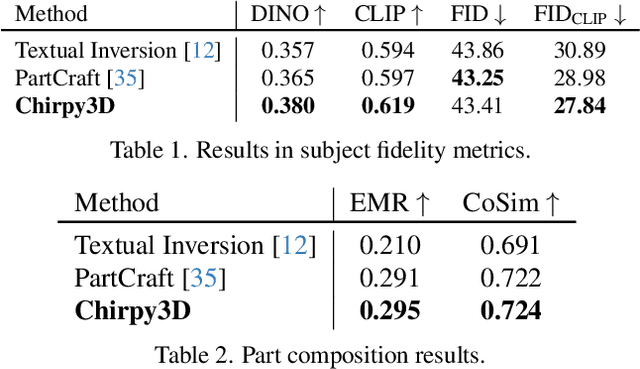
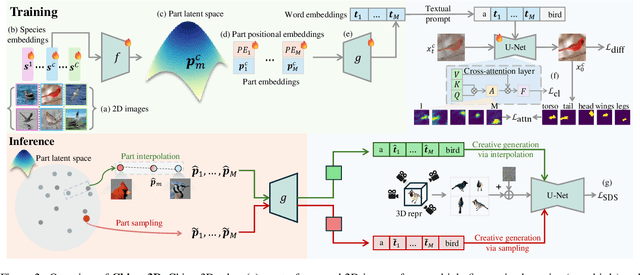
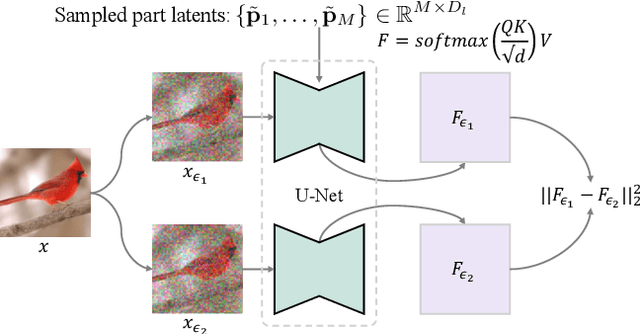

Abstract:In this paper, we push the boundaries of fine-grained 3D generation into truly creative territory. Current methods either lack intricate details or simply mimic existing objects -- we enable both. By lifting 2D fine-grained understanding into 3D through multi-view diffusion and modeling part latents as continuous distributions, we unlock the ability to generate entirely new, yet plausible parts through interpolation and sampling. A self-supervised feature consistency loss further ensures stable generation of these unseen parts. The result is the first system capable of creating novel 3D objects with species-specific details that transcend existing examples. While we demonstrate our approach on birds, the underlying framework extends beyond things that can chirp! Code will be released at https://github.com/kamwoh/chirpy3d.
VersaGen: Unleashing Versatile Visual Control for Text-to-Image Synthesis
Dec 17, 2024



Abstract:Despite the rapid advancements in text-to-image (T2I) synthesis, enabling precise visual control remains a significant challenge. Existing works attempted to incorporate multi-facet controls (text and sketch), aiming to enhance the creative control over generated images. However, our pilot study reveals that the expressive power of humans far surpasses the capabilities of current methods. Users desire a more versatile approach that can accommodate their diverse creative intents, ranging from controlling individual subjects to manipulating the entire scene composition. We present VersaGen, a generative AI agent that enables versatile visual control in T2I synthesis. VersaGen admits four types of visual controls: i) single visual subject; ii) multiple visual subjects; iii) scene background; iv) any combination of the three above or merely no control at all. We train an adaptor upon a frozen T2I model to accommodate the visual information into the text-dominated diffusion process. We introduce three optimization strategies during the inference phase of VersaGen to improve generation results and enhance user experience. Comprehensive experiments on COCO and Sketchy validate the effectiveness and flexibility of VersaGen, as evidenced by both qualitative and quantitative results.
 Add to Chrome
Add to Chrome Add to Firefox
Add to Firefox Add to Edge
Add to Edge